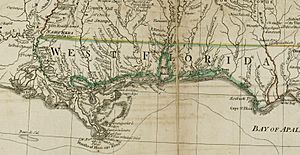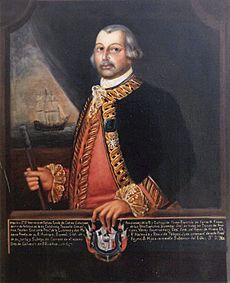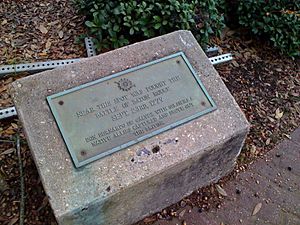Battle of Baton Rouge (1779) facts for kids
Quick facts for kids Battle of Baton Rouge |
|||||||
|---|---|---|---|---|---|---|---|
| Part of the Gulf Coast campaign | |||||||
 Detail from a 1776 map showing British West Florida |
|||||||
|
|||||||
| Belligerents | |||||||
|
|||||||
| Commanders and leaders | |||||||
| Bernardo de Gálvez | Alexander Dickson (POW) | ||||||
| Strength | |||||||
| 398 regulars 400 militia |
400 regulars 150 militia |
||||||
| Casualties and losses | |||||||
| 1 killed 2 wounded |
4 killed 2 wounded 375 captured 30 died of wounds in captivity |
||||||
The Battle of Baton Rouge was a short but important fight during the war between Spain and Great Britain. It happened on September 21, 1779. This battle was part of a bigger plan by Bernardo de Gálvez, a Spanish leader, to take over British lands in British West Florida. Baton Rouge was the second British fort he captured.
Contents
Why the Battle Happened
Spain officially joined the American Revolutionary War on May 8, 1779. This meant they were now fighting against Great Britain. King Charles III of Spain gave permission for his people in the colonies to fight the British.
When Bernardo de Gálvez, who was the Spanish Governor of Louisiana, heard this news on July 21, he quickly started planning. He wanted to capture British forts in West Florida.
Taking Fort Bute
On August 27, Gálvez began his march towards Fort Bute. He led a group of about 520 regular soldiers, many of whom were new recruits. He also had 60 militiamen, 80 free black and mixed-race people, and ten American volunteers.
As they moved up the river, more people joined them, including Native Americans and Acadians. At its largest, Gálvez's force had over 1,400 people. However, the difficult journey caused many to leave before they reached the fort.
On September 7, Gálvez's army attacked Fort Bute. This fort was old and falling apart, and only a small group of soldiers defended it. After a quick fight, the fort surrendered. Six British soldiers escaped and went to Baton Rouge to warn the troops there.
After resting for a few days, Gálvez moved on to Baton Rouge. It was only about 15 miles (24 km) from Fort Bute. When Gálvez arrived on September 12, he found a strong town. It had over 400 regular soldiers and 150 militia, led by Lieutenant Colonel Alexander Dickson.
British Defenses at Baton Rouge
Weeks before, Colonel Dickson had decided that Fort Bute was too old to defend. So, he moved most of his soldiers to Baton Rouge. Starting in July 1779, he built a new fort called Fort New Richmond.
This new fort was made of earth and had sharp wooden stakes (called chevaux de frise) around it. It was also protected by a wide moat, which was 18 feet (5.5 m) wide and 9 feet (2.7 m) deep. The fort had thirteen cannons to defend it.
The Battle Begins

Gálvez first sent some of his men up the river. Their job was to stop messages from getting between Baton Rouge and other British forts.
When he reached the fort, Gálvez couldn't move his cannons forward easily. So, he planned a trick. He sent a group of his less experienced militia into a nearby forest. They made noise and caused a disturbance. The British soldiers in the fort turned their attention to the forest and fired many shots. But the Spanish forces were hidden by trees and only three were hurt.
While the British were busy, Gálvez quickly dug trenches and set up places for his cannons. These spots were close enough to the fort for the cannons to reach. On September 21, he began firing his cannons at the fort.
The British soldiers were shelled for three hours. Finally, Colonel Dickson offered to surrender. Gálvez agreed, but he added a special condition. He demanded that the British also give up Fort Panmure in Natchez. This was a very strong fort that would have been hard for Gálvez to capture by force.
The next day, Dickson surrendered 375 regular soldiers. Gálvez took away the weapons of Dickson's militia and sent them home. Gálvez then sent 50 men to take control of Fort Panmure. He also sent his own militia companies home, left some soldiers at Baton Rouge, and returned to New Orleans with about 50 men.
What Happened Next

When the commander of Fort Panmure heard that Dickson had surrendered his fort, he was very angry. He thought Dickson had given up Panmure just to get better surrender terms for himself.
A local judge named Isaac Johnson wrote about the battle. He said, "In the mighty battle between Governor Gálvez and Colonel Dickson, the Spaniards only lost one man and some say not one, the English lost twenty-five and the commanding officer wounded his head on his tea table". This shows how one-sided the battle was.
The victory at Baton Rouge meant that the British no longer controlled any part of the Mississippi River. The lower part of the river was now firmly under Spanish control. Soon after Gálvez's win, American and Spanish privateers (ships allowed to attack enemy ships) captured several British supply ships on Lake Pontchartrain. One amazing capture was a ship carrying 54 German soldiers and ten to twelve sailors, taken by a small boat with only 14 local Louisianans.
Gálvez was promoted to a higher rank, brigadier general, because of his successful campaign. His brave actions were even written about in poems. He immediately started planning to attack Mobile and Pensacola. These were the last British strongholds in West Florida. His efforts led to the capture of Pensacola, the capital of West Florida, in 1781.
Baton Rouge stayed under Spanish control for the rest of the war. In the 1783 Treaty of Paris, Britain gave both West and East Florida to Spain. Baton Rouge did not become part of the United States until 1821.
See also
 In Spanish: Batalla de Baton Rouge (1779) para niños
In Spanish: Batalla de Baton Rouge (1779) para niños

